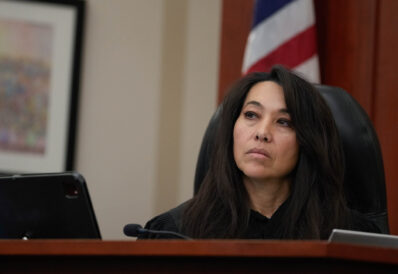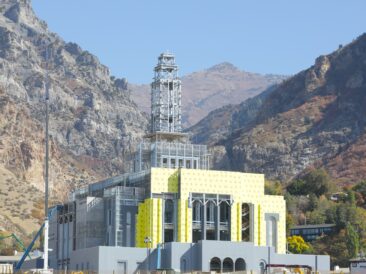History: Carnage in Pole Canyon avenged
Indians’ vengeance claimed the lives of two teenage boys D. Robert Carter
The Walker War officially ended in late May 1854. Brigham Young and Chief Kanosh met with Chief Walkara and some of his warriors in a tent at Chicken Creek near present-day Levan and negotiated a treaty of peace.
Unfortunately, some Indians harbored feelings of hostility against the colonists that no words on a piece of paper could mollify. One such small band of ten or twelve Indians living west of Utah Lake in Cedar Valley refused to make peace. Both George Washington Bean, an Indian interpreter and deputy United States marshal, and Hosea Stout, an attorney who kept a very informative diary, identified these Indians as Gosiutes.
According to Stout, some of the friends and relatives of these Gosiutes had been among the eight or nine Indians wantonly shot down by colonists at Nephi in October 1853. This butchery occurred shortly after Indians massacred four settlers at Uintah Springs. The Cedar Valley Gosiutes declined to make peace until they received compensation for the deaths of their friends and relatives at Nephi, or until they violently avenged the deaths of their fellow Indians by killing a number of colonists.
After waiting almost a year for recompense and receiving none, the Gosiutes decided the time had come for revenge. A number of the Indians traveled to the mouth of Pole Canyon, south of Cedar Fort, and lay in wait. They knew the inhabitants of Cedar Valley visited this canyon to cut firewood and poles. Sooner or later, unsuspecting victims would ride into their trap.
The renegade, revenge-seeking Gosiutes did not have long to wait. Bishop Allen Weeks, a resident of nearby Cedar Fort, sent his teenaged sons, William and Warren, to Pole Canyon in a wagon for a load of poles on August 8, 1854. A short distance from where the boys turned off the main road to drive up the canyon, they met the fury of the Gosiute ambush.
The Deseret News declared the frenzied Indians shot both boys in the chest twice, tore off their scalps and otherwise mutilated their bodies. Thomas Bullock, who took his family on a day trip from Salt Lake City to American Fork two days later, learned of the killings while in the latter settlement. He wrote in the LDS Historian’s Office Journal, “Heard of the Indians killing two boys of bro Weeks in Cedar Valley . . . cutting off arms & otherwise mutilating the bodies.”
When the boys did not return with the poles that evening, the Weeks family worried about the safety of their sons. Very early in the morning on August 9, Allen Weeks accompanied by his brother-in-law, Eli Bennett, traveled to Pole Canyon. They followed the wagon tracks to the massacre site, where they found the bodies of William and Warren.
The two heartbroken men returned to Cedar Fort and informed the residents of the tragedy. Later that day, a group of townspeople returned to the murder site to take home the mangled bodies of the Weeks boys.
The Deseret News reported nearly all of the Indians in Cedar Valley were very friendly, and searchers only located three moccasin tracks near the murder site. From this evidence, the newspaper concluded: “It’s highly probable, and indeed quite certain, that this merciless deed was committed by a few reckless savages, without the previous countenance or knowledge of any tribe, or even of the majority thereof.”
Worried that the murder of the boys would result in more barbaric acts against innocent Indians, Brigham Young wrote a letter containing some instructions to William D. Huntington in Utah County. The Mormon leader told Huntington to inform the friendly Indians that no harm would come to them because of the bad conduct of a few Indians in Cedar Valley. Young also instructed Huntington to tell the colonists to treat the Indians as though nothing had happened.
President Young also wrote a letter of sympathy to Bishop Weeks. Young counseled Weeks to seek out the guilty Indians but not to react negatively toward those Indians who were innocent.
On a broader scale, the Deseret News announced to its many readers the official LDS Church policy concerning the event:
“While we deeply sympathize with the bereaved relatives, we discern no cause for deviating from the constantly counseled policy of kind, tho’ firm treatment of the Indians generally; but it certainly is self evident that no pains should be spared in finishing forts, securing crops, and having everything in the best possible condition for any sudden outbreak.
“Inasmuch as the Indians prove energetic and faithful in delivering up transgressors against us, to be tried by our laws, any white person for unjustifiably killing or abusing an Indian, will be rigorously dealt with; for the whites know how to do right, having been often and plainly taught.”
In an effort to help improve relations with the Native Americans, the people of Provo provided a feast for the Indians on August 14. The city’s inhabitants donated three beeves, four barrels of biscuits and a large quantity of vegetables. Indian interpreter George Washington Bean also helped distribute a substantial amount of clothing.
By treating the innocent Indians fairly, Young hoped to encourage them to help find and bring to justice the parties guilty of killing the Weeks brothers. This policy seems to have paid off.
The Deseret News reported on August 17: “Several friendly Indians have assured Governor Young that they will use their best skill and efforts to search out, and deliver up the murderers to be dealt with according to law.”
David K. Craft, who was constable at the time, and others talked to the friendly Indians, and a number of Utes, including Yan Tan, took up the trail of the murderers. On August 21, the posse returned with their prisoners, Antelope and Longhair, and two other Indians belonging to the same band.
Authorities transported the four Indians to Salt Lake City in two wagons and delivered them to Indian interpreter Dimick B. Huntington. The LDS Historian’s Office Journal called them “ferocious looking men.”
The U.S. District Court was called into special session on August 23, to conduct the trial against the two suspects. A grand jury also organized that day to hear testimony against the two Gosiutes and decide whether there was evidence enough to send them to trial. On August 25, the grand jury indicted Antelope and Longhair for murder.
The trial of the two Indians, the first in Utah where Native Americans were arraigned, began August 28 in Salt Lake City. U.S. District Attorney Joseph Holman acted as prosecuting attorney, and Hosea Stout and Almon W. Babbitt defended the accused. Judge Leonidas Shaver presided, and George Washington Bean acted as interpreter.
Stout and Babbitt made an effort to set aside the charges and claimed the court had no jurisdiction over the Indians. The court overruled both pleas, and as the result of an argument between Babbitt and Judge Shaver, Jesse C. Little replaced Babbitt on the defense team.
The four-day trial ended August 31. Concerning the outcome, Stout wrote in his diary: “The evidence was plain & positive both from an eye witness [An Indian who watched the murders testified.] & their own confessions, without the first paliating circumstances on which to hang even a pretended plea of defence In the after noon the pleas of the attornies were made and Court adjourned till 7 P.m when the virdict of the jury was given of ‘Guilty as charged.’ “
The next day, the court pronounced the sentence of death by hanging. The judge set the day of execution for September 15, 1854.
Joseph L. Heywood, Utah Territorial Marshal, sent out invitations to attend the execution. The invitation received by George A. Smith read: “You are hereby solicited to accompany the Procession to the execution of the Indians Longhair and Antelope on the 15th Inst., Col Little’s Omnibus will be in waiting at the Council House at ? past one O’clock PM.”
On the day of the execution, U.S. Army Colonel Edward Steptoe and a company of U.S. Dragoons accompanied the procession to the execution site. Stout located the place as being “some two miles below the Jordain on the other side of the river.” He also reported that only a small group attended due to the fact that authorities kept the execution site a secret.
Provo resident George Washington Bean attended the hanging. He wrote in his autobiography: “I, as Deputy Marshal and Interpreter, had to bring those two Indians to justice and to the gallows. It was hard on me, but the Indians had to get the idea of right and wrong established in their minds. We had to get their heads and hearts turned right through private and group contacts and not by preaching. . . .
“I officiated . . . in the matter, and led them to the gallows. They said they were ‘Braves’ and would not die like a squaw, so walked straight to their doom.”
Thomas Bullock and an acquaintance also attended the execution. They rode to the site in a government wagon, but the two men had to walk home. Bullock sarcastically complained in the LDS Historian’s Office Journal, “We had to walk home Uncle Sam too poor to pay for their ride.”
The execution of Antelope and Longhair by hanging almost caused yet another uprising. The Indians considered hanging to be a very unflattering, disgraceful way to die. Almon W. Babbitt pointed this out in a letter he wrote to The Council Bluffs Bugle: “Many of their [Antelope and Longhair’s] tribe were in and around the city, and although they admitted that they deserved death, yet they objected to the mode — to-wit: hanging by the neck. They immediately commenced their depredations in retaliation.”
During these troubled times, Allen Weeks feared for the lives of the inhabitants of Cedar Fort. In an early October 1854 letter to Brigham Young, Weeks wrote that the Indians were “lirking around in hopes to get some men to take into the kanion to Hang.” These lurking Indians told passing immigrants “they were determined to have two men out of this fort to Hang & if they could not get men they would take Boys or Children.”
Brigham Young’s policy of pacification eventually calmed the Indians, and with the exception of the occurrence of a major problem when a party of Shoshones attacked a camp of Utes at Provo, there was little violence for the rest of 1854.
Near the end of the year, Brigham Young told the Utah Territorial Assembly:
“Peace with the Indians has been preserved during the year, although detached parties of the Utahs have been unfriendly, in one instance two citizens had been killed.
“I have uniformly pursued a friendly course of policy toward them, feeling convinced that independent of the question of exercising humanity toward so degraded and ignorant a race of people it was manifestly less expensive to feed and clothe than to fight them.”
• D. Robert Carter is a historian from Springville.
• The people of Lehi honored Yan Tan, a son of Chief Wanship, for the aid he offered in capturing Antelope and Longhair. The chief’s son was no stranger to the people of Lehi. He came into town in 1854 carrying a letter of recommendation from Brigham Young. The Mormon president addressed the letter, which was dated September 4, to Lehi’s Bishop David Evans.
Young’s letter read: “The bearer of this Yan-Tan is anxious to live among the Whites, and has expressed his desire to live in your ward. You will please find him a room in some place that will be suitable and let him live among you and hunt or fish just as he chooses, or if he wishes to farm assist him in so doing, as he says he now does.”
Evans and the people of the settlement treated Yan Tan and his little band of Utes amicably, and the Indians stayed among the settlers or passed through the town as they wished.
Since Yan Tan helped capture the renegade Gosiutes who killed William and Warren Weeks, the people of Lehi showed their gratitude by building the Indian and his band a three room, adobe home measuring 42 feet long and 16 feet wide. Workmen finished the house sometime before George A. Smith and Edson Whipple visited Lehi early in February 1855.
Unfortunately, Yan Tan died before he could sufficiently enjoy the new structure. On September 14, 1855, George A. Smith notified the Deseret News of Yan Tan’s death near Provo. The Indian’s family evacuated the new house at that time saying “they could not bear to remain in the house where he had lived.” Smith called Yan Tan “one of the best dispositioned and most friendly chiefs in the mountains.”
According to Lehi historian Richard S. Van Wagoner, the Indian House then “became a temporary shelter for new arrivals in town.” Workmen demolished it around the turn of the century.



